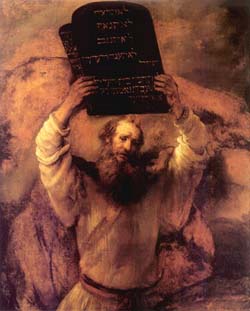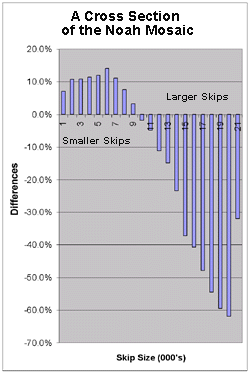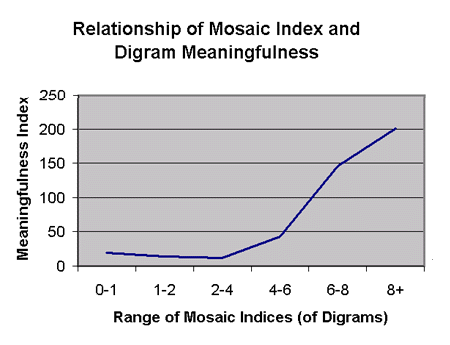| |
|
The Mosaic: A Radically Different Kind of Bible Code
|
 The saga of the Bible code controversy could possibly be entering an entirely new chapter that might be noticeably different than preceding ones. A decidedly different form of evidence has been unearthed by our researchers, and it exhibits characteristics that could reconfigure the nature of the whole battle ground between code opponents and proponents.
The saga of the Bible code controversy could possibly be entering an entirely new chapter that might be noticeably different than preceding ones. A decidedly different form of evidence has been unearthed by our researchers, and it exhibits characteristics that could reconfigure the nature of the whole battle ground between code opponents and proponents.
The nature of this evidence is much more amenable than current forms of evidence to scientific testing, and the application of statistical tests that could produce highly significant results. We have called this new form of evidence "mosaic" because of its similarity to that form of ceramic art work—with its thousands of tiny pieces intentionally arranged to produce visually striking images. This name seems further appropriate because the first evidence of it came from the Mosaic books of the Bible -- the Torah -- authored by Moses. (In actuality the term has its origins in the Greek word for the artwork of the muses of mythology.)
We may some day regard Bible mosaics as being far more remarkable than the massive 43,000 square feet of mosaic masterpieces that cover the walls and ceilings of St. Mark’s Basilica in Venice. If you have seen these, you would agree that they are astonishingly beautiful -- an enduring testimony to the painstaking artistry of Venetian masters of many centuries past. Even these, however, could eventually pale in comparison to the artistry of the ELS mosaics that may underlie the earlier chapters of the book of Genesis.
|
Noah Mosaic Yields Unusual Patterns
The Noah Mosaic is a striking example of the new phenomenon. Let’s take a look at this intriguing ELS and see how it is the exact opposite of the traditional ELS of interest. Instead of each ELS in the mosaic consisting of many letters, each Noah ELS only consists of two Hebrew letters (Noon-Khet). How could anyone have such a short name? In a language as terse as Hebrew, this kind of thing is quite possible, although even there two letter names are fairly uncommon.
Instead of just looking at those appearances of the Noah ELS with the shortest skips, we gathered information on its appearances within the search text (Genesis 1:1-17:27) at all possible skip sizes. These skip sizes range from 1 to 20,477. This ELS appears not just a few times in Genesis 1-17. It shows up a mind boggling 488,748 times! This fact isn’t remarkable, however, because that is how many times it should appear by chance. This phenomenon is inherently true for any two-letter ELS -- and for any search text -- you may pick. The grand total of all ELS appearances at all possible skip sizes must equal the number expected by chance. What is so unusual about the Noah ELS, however, is the way that these occurrences appear at different skip sizes.
How can we begin to get our hands around something that crops up almost a half-million times? One possible way is to sort all these occurrences into buckets according to skip size, and that is what we have done. We formed 21 buckets based on bands of skip sizes that are 1,000 wide. The first skip band bucket includes occurrences of the Noah ELS with skips of 2-1,000. The second bucket is for occurrences with skips of 1,001-2,000. And so forth.
Buckets Full of Noah ELSs
Now each of these skip band buckets is brimming with Noah ELSs. The first one has 49,804 of them, and the second one has 48,990. Each later bucket has fewer Noah ELSs than the immediately preceding one, but this shouldn’t be a surprise either. That is as one would expect. After all, ELSs with bigger skips cover a larger span of the search text, so we should naturally expect that there will be fewer of them that can fit within a search text of fixed size.
In studying the behavior of the Noah ELSs within the Genesis text, what we do is compare the actual number of appearances within each skip band bucket and the expected number of appearances. Now the math for determining the expected number of times it should appear is simple and undisputed. It is one of the things that Bible code skeptics and proponents will agree on because it is so basic and obvious, once a little high school math is done. We know exactly how many times each Hebrew letter appears within Genesis 1-17. And we can count the number of locations where two-letter ELSs of different skip sizes can appear. When this information is dumped into a simple, algebraic formula, out comes the expected number. That set of calculations is quite analogous to a much simpler situation. Suppose you want to know how many times a fair coin will turn up with “heads.” What you do is simply multiply the number of times you flip the coin by 50%. It’s the same kind of thing.
If you flip a fair coin 100 times, you would expect that heads would show up 50 times. Now we all know that if you do that, there is a good chance that the actual number of heads you get will be somewhat different from that. It is also intuitive that if you repeat this experiment any number of times, you should get actual numbers of heads that bounce randomly above and below the expected number of 50, and that each time the actual number shouldn’t differ too much from 50.
The Nature of the Mosaic Phenomenon
A possible analogy to the Noah mosaic could be a scattering of iron filings thinly spread over a piece of paper, where each individual filing represents a Noah ELS. Ordinarily, each tiny filing would be oriented in a random direction. However, when you bring a magnet up close underneath the sheet, most of the filings re-orient along the magnetic force field lines induced by the magnet. With so many of them aligned in this way, it is clear that the patterns they form are highly non-random.
So, what is this pattern that is exhibited in the Noah mosaic? For most of the buckets, the actual number of times the Noah ELS appears is far greater (or less) than expected, and so much so that chance must be ruled out as a plausible explanation. Furthermore, the huge variations that show up follow a beautifully smooth wave-like pattern, being consistently far above expected for skip sizes under 9,000 (labeled “smaller skips” in the graph below) and consistently far below expected for skip sizes above 12,000 (labeled “larger skips”).

|
You can see it for yourself in the above graph. Our skip buckets are arranged by skip size, with the results from the bucket with the smallest skips (2-1,000) at the far left, and the results from the bucket with the largest skips (over 20,001) at the far right.
How can such dramatic variations be explained? There has to be some cogent explanation, or multiple explanations. All of this leaves one big question begging for an answer? What is the cause of this mosaic? Let’s look at some alternative hypotheses:
First, the mosaic could be the natural result of chance variations in letter frequencies within the text of Genesis 1-17, such as one would find in any text.
Second, the mosaic could be the result of substantial variations in letter frequencies within Genesis 1-17 that clearly exceed those exhibited by various other literal texts. This circumstance could suggest either that certain key words appeared with an unusual degree of repetition within the text or that there was intent on the part of the author to produce text with such unusual variations through various more complex means than heavy repetition.
Things like the Noah mosaic don’t just happen. What we saw was that the percentage of Khet’s and Noon’s in both the beginning and ending chapters of Genesis 1-17 was far less than the average for all those chapters combined. Given that, we should expect that there would be a great lack of Noah ELSs in the high skip size ranges. Correspondingly, we should also expect that there would be a noticeable excess of Noah ELSs with shorter skips. In other words, the variations in letter frequency among chapters was at least a significant contributor to the existence of the Noah mosaic.
We built a model based on the actual letter frequencies between the individual chapters within Genesis 1-17 and used it to see if these could explain the kinds of variations in the number of Noah ELSs appearing at different skip size ranges. That model very roughly emulated the effect that we have been describing. But that is not the end of the matter.
Did An Incomparable Chess Master Arrange the Letters of Genesis?
A world championship chess match takes place. The victor executes an amazing series of unusually brilliant moves to clinch the title. After the match a detracting reporter writes, “Each move was merely the repositioning of a common chess piece on a board of squares. Why should anyone be impressed?”
Obviously, the reporter was oblivious to the incredible intricacies of world class chess. And yet he was right in observing that any chess player’s moves can be explained away as a series of seemingly unremarkable, mechanical steps.
It took a highly unusual arrangement of letters within Genesis 1-17 to produce a very significant mosaic effect for the Noah ELS. Similarly, it would take a highly unusual arrangement of the same letters to produce major mosaic effects for numerous other ELSs which are meaningful Hebrew words.
An Extensive Test
After conducting further tests, we determined that it would be asking too much of chance to come up with highly unusual letter arrangements that will produce major mosaic effects for an unexpectedly large number of meaningful ELSs.
How did we do this? We embarked on a complete compilation of two key indicators for all possible digrams (two letter ELSs):
-- The first indicator was a completely objective measure of “meaningfulness.” The more times the digram appeared in the Tanakh, the more “meaningful” it was. To narrow the huge range of differences in how many times the digram appeared (i.e., from 1 to 7,700).
-- The second indicator we compiled was a measure of the extent of the mosaic effect within Genesis 1-17. We assigned all digrams to different categories depending on the size of the mosaic effect that was exhibited and then took the average number of occurrences of each digram within the Tanakh (as the measure of “meaningfulness”). The higher the mosaic index, the stronger the mosaic effect.

|
We found a very strong relationship between the strength of the mosaic effect and the meaningfulness of different digrams. We noted a 94% correlation between the extent of the mosaic effect and the average meaningfulness of the digrams in each category. [For more details, please refer to the article at the end of the July 2024 Digest issue.]
An Example of Visual Images Formed By A Mosaic
Within Isaiah 53 an extensive mosaic has been discovered. It is comprised of 21 visual crosses formed when a trigram (three letter ELS) crosses itself, with the middle letter of each trigram being the same. Click here to view this presentation. Even though 3.64 such crosses are expected to appear by chance, 21 actually show up. The meaning of this trigram, as well as its backward spelling, tie very tightly to the content of the literal text.
|
Enjoy finding your own Bible codes.
Bible code search software is available in our online store.
Subscribe Free! Sign Up Today!
Become a member of the non-profit Isaac Newton Bible Code Research Society.
Not only will you be part of the world's leading organization researching and publicizing Bible and Torah codes, but you will receive Bible Code Digest absolutely free, including . . .
- Latest Bible Code News
- Easy-to-Understand Bible Code Feature Articles
- Exciting Inside Information from Leading Code Researchers
- Details of Great New Discoveries
- Summaries of the Latest Battles Between Code Proponents and Skeptics
Stay current on Bible code news. Be first to hear about all of the latest Bible code discoveries.
Sign up to receive Bible Code Digest today.
|
|







Click here
and sign up to receive Bible Code Digest with no cost or obligation.
 Code Skeptics' Arguments Trashed Ever since the first Bible codes were announced, skeptics have been saying, "Oh, well, you can also find codes like that in books like War and Peace and Moby Dick."
We took the time to examine this notion and the best example of it that the skeptics have been able to come up with. The results of our research have completely blown away their theory.
Click here to see for yourself.
NEW: Second Study Undermines
Skeptics' Main Objection
to Codes
Click here for report |











